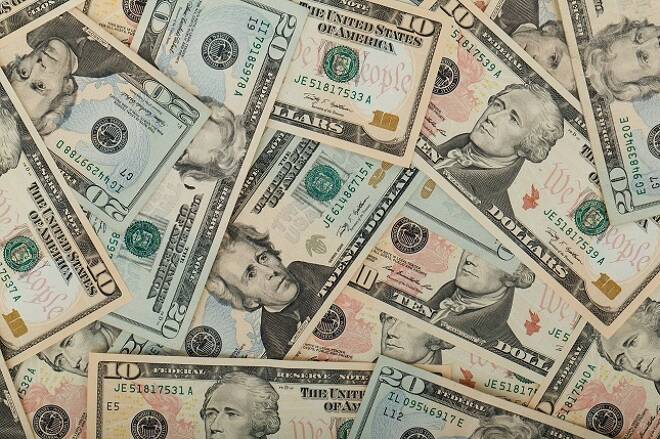Advertisement
Advertisement
Receding Risk Aversion Drives Dollar Lower Against Most Major Currencies
By:
The U.S. Dollar finished lower against a basket of major currencies last week after an easing of tensions over the trade dispute between the United States and China encouraged investors to lift dollar hedges. The Reserve Bank of Australia (RBA) warned on risks to its outlook from U.S.-China trade tensions and weak wages, while reaffirming its next interest rate move would likely be a hike. The New Zealand Dollar was boosted after data showed its economy grew at a faster pace than expected in the second quarter. The Bank of Japan (BOJ) reiterated last Wednesday that it would keep interest rates extremely low “for an extended period,” holding to forward guidance it first introduced in July.
The U.S. Dollar finished lower against a basket of major currencies except the Japanese Yen last week after an easing of tensions over the trade dispute between the United States and China encouraged investors to lift dollar hedges. This led to sharp gains in higher risk and emerging currencies, pressuring the greenback.
Essentially, the dollar hit a 2-1/2 month low on reduced safe haven demand amid a switch in investors’ views that the Sino-U.S. trade conflict would not lead to an immediate global shock.
For the week, the December U.S. Dollar Index settled at 93.798, down 0.707 or -0.75%.
To recap, on Monday, the Trump administration announced it will impose 10 percent tariffs on about $200 billion of imports from China effective September 24. Traders had priced in the possibility of a 25 percent tariff. However, Trump did say in a statement the tariffs would rise to 24 percent on January 1, 2019.
On Tuesday, China said it will institute new tariffs on U.S. goods worth $60 billion on September 24. The media outlet said the Asian country’s tariff rate on a list of 5,207 U.S. products will range between 5 percent and 10 percent. This was also less than the market expected. Some were looking for China to go after the supply chain by limiting exports of strategic metals and small electronic components.
For weeks leading up to these latest tariffs, investors had been operating under the notion that they would cause a global economic slowdown. This led investors to buy the U.S. Dollar as protection because it is seen as the world’s reserve currency and the safest place to put money during an economic downturn.
The dollar’s losses may have been limited by expectations of a Fed rate hike at next week’s 2-day monetary policy meeting. The Fed is widely expected to raise its benchmark interest rate by 25 basis points.
Australia Dollar
The Australian Dollar, a proxy of China-related trades as well as gauge of risk sentiment, climbed to a three-week high last week. It also produced its biggest weekly advance in 14 months. Additionally, S&P Global Ratings revised its outlook on triple-A rated Australia to stable from negative on Friday, providing the Aussie with a further lift.
In its monetary policy minutes, the Reserve Bank of Australia (RBA) warned on risks to its outlook from U.S.-China trade tensions and weak wages, while reaffirming its next interest rate move would likely be a hike.
The RBA also said “Significant tensions” around trade policy are a “material risk” to the global outlook. Unemployment is expected to decline gradually toward 5 percent and wage growth is expected to increase gradually as spare capacity in the labor market is absorbed.
Additionally, GDP growth is likely to remain “above potential” through the forecast period and inflation is “likely to increase over time”.
Finally, the minutes reiterated there was “no strong case” for a near-term adjustment to monetary policy.
New Zealand Dollar
Besides the easing of tensions over the trade dispute between the U.S. and China, the New Zealand Dollar was boosted after data showed its economy grew at a faster pace than expected in the second quarter.
Gross domestic product rose 1 percent quarter on quarter in the three months through June, according to Stats NZ, up from 0.5 percent in the first quarter and ahead of a median forecast of 0.7 percent.
Japanese Yen
The Dollar/Yen rose sharply last week as investors exited safe-haven long positions in the Japanese Yen as fear of an escalation of the trade war between the United States and China fell following the latest round of tariffs announced last Monday and Tuesday.
The “risk on” mood came about as optimism towards U.S.-China trade issues cleared the path for the dollar’s rise.
Higher U.S. yields, particularly the two-year yield’s rise, added further momentum to the dollar’s gains versus the yen ahead of next week’s Fed meeting. The two-year Treasury yield climbed to a record high last week on the back of receding risk aversion and expectations for a hawkish Federal Reserve meeting this week.
Also last week, the Bank of Japan (BOJ) reiterated last Wednesday that it would keep interest rates extremely low “for an extended period,” holding to forward guidance it first introduced in July.
The central bank decided to stand pat on policy after making a number of tweaks in July to prepare for a longer-than-expected fight to lift inflation, which has yet to reach the central bank’s 2% target.
About the Author
James Hyerczykauthor
James Hyerczyk is a U.S. based seasoned technical analyst and educator with over 40 years of experience in market analysis and trading, specializing in chart patterns and price movement. He is the author of two books on technical analysis and has a background in both futures and stock markets.
Advertisement
